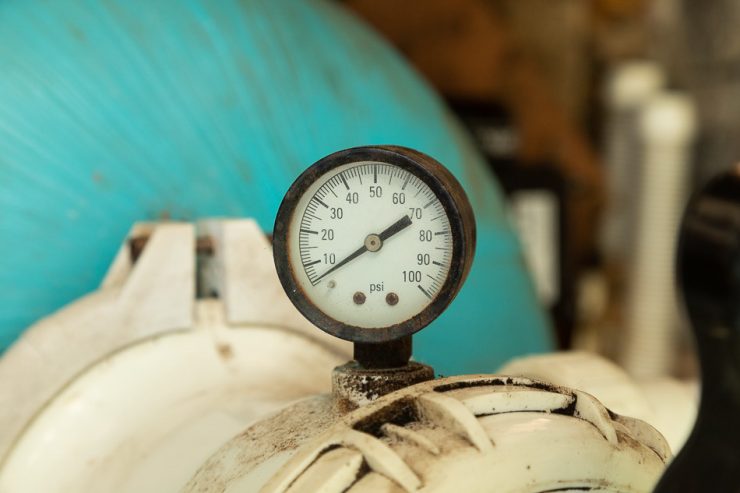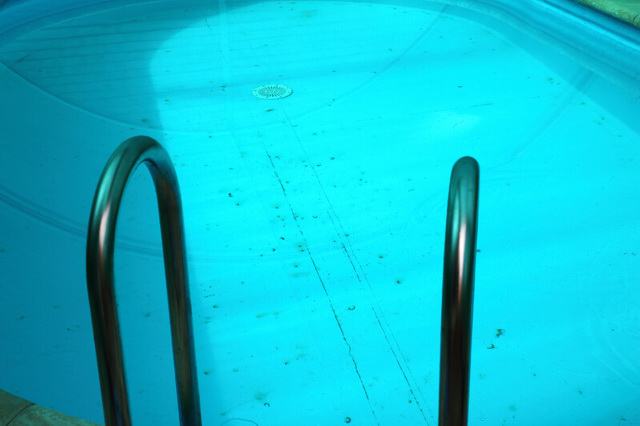Isn’t it frustrating when you’ve recently cleaned your pool filter and now the pressure is still increasing, over a matter of hours or days? Well, rest easy and read on to find out why your pool pump or filter pressure is rising after cleaning.
The most common reasons why a cartridge, sand, or DE filter’s pressure rises quickly, even after cleaning or backwashing, is a clogged or blocked filter, algae or old filter elements. If any of these things are wrong, the pressure can rise rapidly in minutes, hours or days. Other causes include faulty pressure gauges, blocked return lines and too much DE.
Keep reading for a more detailed look at the reasons for high filter pressure, even after backwashing or cleaning your filter.

Article Contents
1. Blockage In Return Line
Although this is a rare occurrence it’s also one of the most dangerous causes of rising filter pressure. A blocked return line is the easiest issue to identify because of how rapidly the pressure will rise.
After cleaning the pool and turning everything back on, if your return line is blocked, the gauge will go from 0psi to 30-40psi rapidly (within minutes). Other ways to identify a blockage in the return line are to watch the skimmer and the filter tank.
With the skimmer, a blocked return line will reduce the skimmer’s suction ability. This usually means the water from the pump can’t flow through the filter, or that the water can’t flow through the filter to the return line.
This intense back pressure pushing back into the filter could cause the tank to bulge. If left unresolved, there’s a possibility that the unit will explode, resulting in pool damage and personal injury.
The most common reason for a blocked return line is debris build-up from faulty or old filter elements. One pool professional even found a broken-off piece of a pool heater had lodged in the check valve of a customer’s pool.
A blocked return line is the only cause of high filter pressure that will result in a rapid spike in pressure (in a matter of minutes).
2. Blocked Cartridges
If your pool uses a cartridge filter, blocked cartridges could be the cause of high filter pressure. Even if you’ve recently cleaned the cartridges, they could still be blocked.
Over time, cartridges wear down and won’t filter the pool as well as they once did. It’s recommended to replace your cartridges every 3-4 years. Or if you have a single cartridge filter, it’s best to replace it every 3-6 months to maintain a good water flow.
Some of the reasons that cause cartridges to become blocked are hardened muriatic acid, calcium deposits, and a build-up of debris.
Muriatic acid
Muriatic acid is a popular cleaning agent for cartridge filters. If it’s not applied at the correct time during cleaning, it’ll harden and block the cartridges. Before applying the muriatic acid, you need to hose down the cartridges to rid them of oils (like sunscreen). It’s a simple but important step to extend the life of the cartridges.
Because muriatic acid is a chemical agent, disposing of it properly is vital to maintain your and your environment’s health. We have a full article on how you get rid of muriatic acid safely and securely.
Calcium Deposits
If your pool is a saltwater system with a cartridge filter, poorly maintained cartridges will collect saltwater particles and these ions will calcify on the cartridges over time. This will create areas of calcium deposits on the cartridge that will block water flow and result in high pressure.
Debris Build-up
Potentially the most likely cause of blocked cartridges is a build-up of debris in the filter. Cartridges that are old won’t filter debris very well, creating pockets of lodged debris preventing proper filtration. This then results in high filter pressure that builds over a few hours or a day or two.
This is why regular cleaning and replacing of cartridges is the simplest solution to a blocked cartridge. Blocked cartridges in four cartridge filter systems can be harder to discover. It doesn’t really affect the pressure gauge so it’s important to keep to the recommended replacement timeframe.
However, if your cartridges are relatively new, they may become blocked because of a poor cleaning routine. It’s important to hose down each cartridge properly each week to preserve its functionality.
To ease the hassle of hosing down each cartridge, this cartridge cleaning tool will help reduce the time and energy spent cleaning.
- Have your filter cleaned in no time
- Cleans faster than a garden hose
- Fits most pool filters & standard garden hoses
It’s rated 4.3 stars out of 2,407 reviews. It has multiple holes along each branch to push water through to clean. Many reviewers love the time it has saved them when cleaning. However, others have noticed it provides less pressure than their yard hose.
3. Too Much or Too Little DE
If you have a DE filter system, you’ll know the importance of following the manufacturer’s recommended amount of DE powder.
Choosing to use more DE powder than what’s recommended will block the filter itself and prevent proper filtration. However, if you use too little, there won’t be enough substrate to trap and filter debris from the pool efficiently.
4. Damaged DE Filter Grid
DE filter grids may become damaged if there’s a lot of large debris passing through them. Or it may be damaged as a result of wear and tear over time.
A high filter pressure with DE filter system is indicated by an increase of pressure by about 10 psi.
If your pool gauge is giving you this rise within a week (after backwashing), it may be time to replace the grids. DE filter grids have a lifespan of about 3-4 years so if your grids are this old, it’s time to replace them.
Another reason for a damaged DE filter grid is if it’s being used in a saltwater pool. As mentioned above, saltwater particles can become trapped and eventually calcify. The calcium deposits will create undue weight and pressure on the grid causing damage.
5. Faulty Pressure Gauge
If you’re seeing a high pressure on your gauge but everything in the system is working perfectly, it could be the gauge giving you a false reading.
Even though it’s not a very common occurrence, the pressure gauge can stop working. It may be due to a manufacturer’s defect or just wear and tear.
The simplest way to test if your gauge is giving you an incorrect reading is to switch everything off and watch the gauge. With everything off, the dial should steadily fall down to 0psi. If it doesn’t and stays at 10psi, then you know it’s faulty. And that it’s giving you a false high-pressure reading.
Most manufacturers will sell replacement gauges however some pool owners have opted to buy the MEASUREMAN pressure gauge.
- Fits most filters with a 1/4" NPT thread
- Suitable for pool & spa filters
- Accurate, quality stainless steel & brass components
It’s rated 4.7 stars out of 2,736 reviews on Amazon. It comes in a few different psi ranges and pool owners have noticed its superior integrity and reliability over factory replacements. Though, a note of caution is to make sure this gauge will fit your filter model before purchasing.
6. Algae or Poor Water Quality
Algae is the bane of pool owners everywhere. Nothing blocks a filter up and causes high pressure faster than algae. It blocks up all filters including sand, cartridge, and especially DE filters.
Because algae is microscopic you may not even know you have it. And it can stay in the pool filter much longer than you’d think.
You may have already shocked your pool or thought you got rid of the algae, but it may in fact still be in the water. If you suspect you’re getting high-pressure readings because of algae, learn how to prevent and remove algae from your pool in our other article here.
Once you kill the algae, you’ll just need to stick with the filtering process and keep cleaning the filter when the pressure is high. It will be a tedious and frustrating process but you’ll get there if you keep it up.
As you work to clear the water, the pressure will likely stay relatively high until the dirt or algae is cleared. However, to help speed up the cleaning process you can use a pool clarifier or a flocculent.

What is a Flocculent?
A flocculent is a chemical that binds to debris in a pool and settles it all on the bottom of the pool. Then the dirt is easily vacuumed out of the pool.
It’s most commonly used in pools with a sand filter because of the sand filter’s ability to Vacuum to Waste. That is, you can vacuum your pool bypassing the filter and sending it out of the backwash hose or outlet. However, it can be used with DE and cartridge filters too.
7. Closed Valves that Should be Open
A reader recently wrote in with the solution to his high filter pressure. He found that the valves to the return lines were closed. They should have been open.
Essentially, this is a blockage. A blockage after the pump (pressure side), causes high filter pressure.
So, if you’ve been recently working on your pool filter or pool system, make sure you open the appropriate valves.
Final Thoughts
As you may have noticed, sand filters aren’t mentioned much here. This is because there are no technical elements in them to cause the high pressure. However, if there is high pressure in your sand-filtered pool, a sand change will most likely solve any pressure issues.
Hopefully now you know the cause of your high filter pressure and how to fix it.




I just changed the sand in my filter and the psi jumped slowly after back washed. Water from the return slowly became slower and slower returning back to the pool.i added 3 bags of sand, as told to do so by my pool co.
It sounds like there might be a few issues going on after changing the sand in your filter. Here are some potential causes and solutions:
1) Incorrect sand level: If you added too much or too little sand, it could affect the filter’s performance. Make sure you’ve added the correct amount of sand according to your filter’s specifications. You typically want to fill the filter tank about two-thirds full with sand, but it’s best to consult the manufacturer’s guidelines.
2) Sand not properly distributed: When adding new sand, it’s essential to ensure that it’s evenly distributed in the filter tank. If the sand isn’t spread out uniformly, it can create channels or areas of higher resistance, leading to decreased filtration efficiency and increased pressure. Try manually redistributing the sand in the filter tank to ensure even distribution.
3) Faulty multi-valve or filter components: If the pressure continues to rise abnormally even after backwashing and rinsing the filter, there may be an issue with the multi-valve or other components of the filter system. Inspect the multi-valve for any signs of damage or wear and ensure that it is functioning correctly. Additionally, check for any leaks or obstructions in the filter system that could be causing reduced water flow back to the pool.
4) Check the pump pressure: Make sure the pump pressure is correct. If the pressure is too high or low, this could be what’s causing the issue. Check out our article here: https://www.myperfectpool.com.au/normal-pool-filter-pressure-range.html
Thanks for the great hints and advice.